Note
This is a community plugin, an external project maintained by its respective author. Community plugins are not part of FiftyOne core and may change independently. Please review each plugin’s documentation and license before use.
FiftyOne + Weights & Biases Plugin#
Track your computer vision experiments with complete data-model lineage.
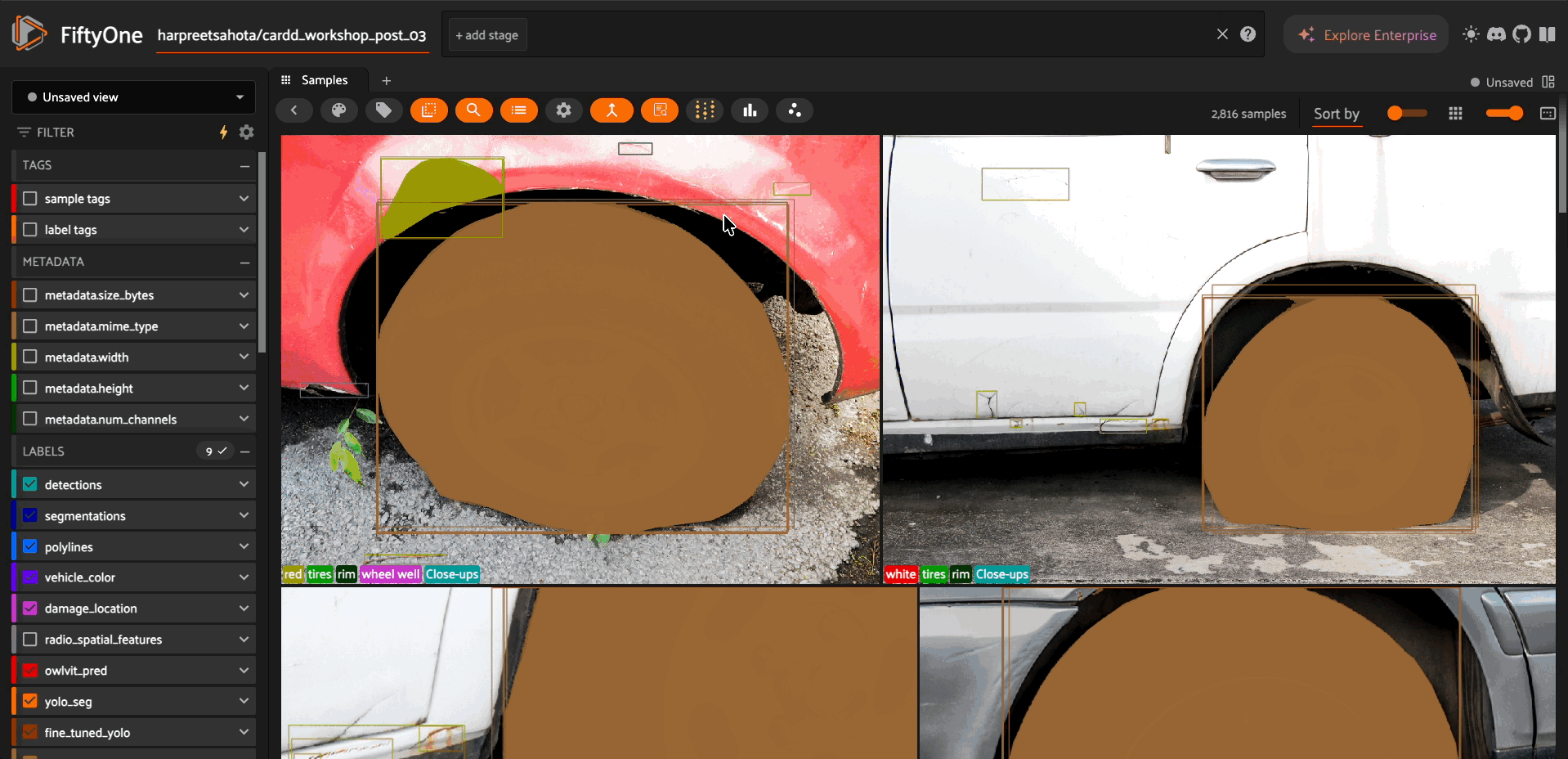
This plugin connects FiftyOne datasets with Weights & Biases to enable reproducible, data-centric ML workflows.
What You Can Do#
Track training data - Log curated FiftyOne views as WandB dataset artifacts
Track model predictions - Log inference results with detection-level granularity
Track VLM outputs - Special support for vision-language model workflows
Reproduce experiments - Recreate exact training views from WandB artifacts
Compare strategies - A/B test data curation, model versions, and prompting approaches
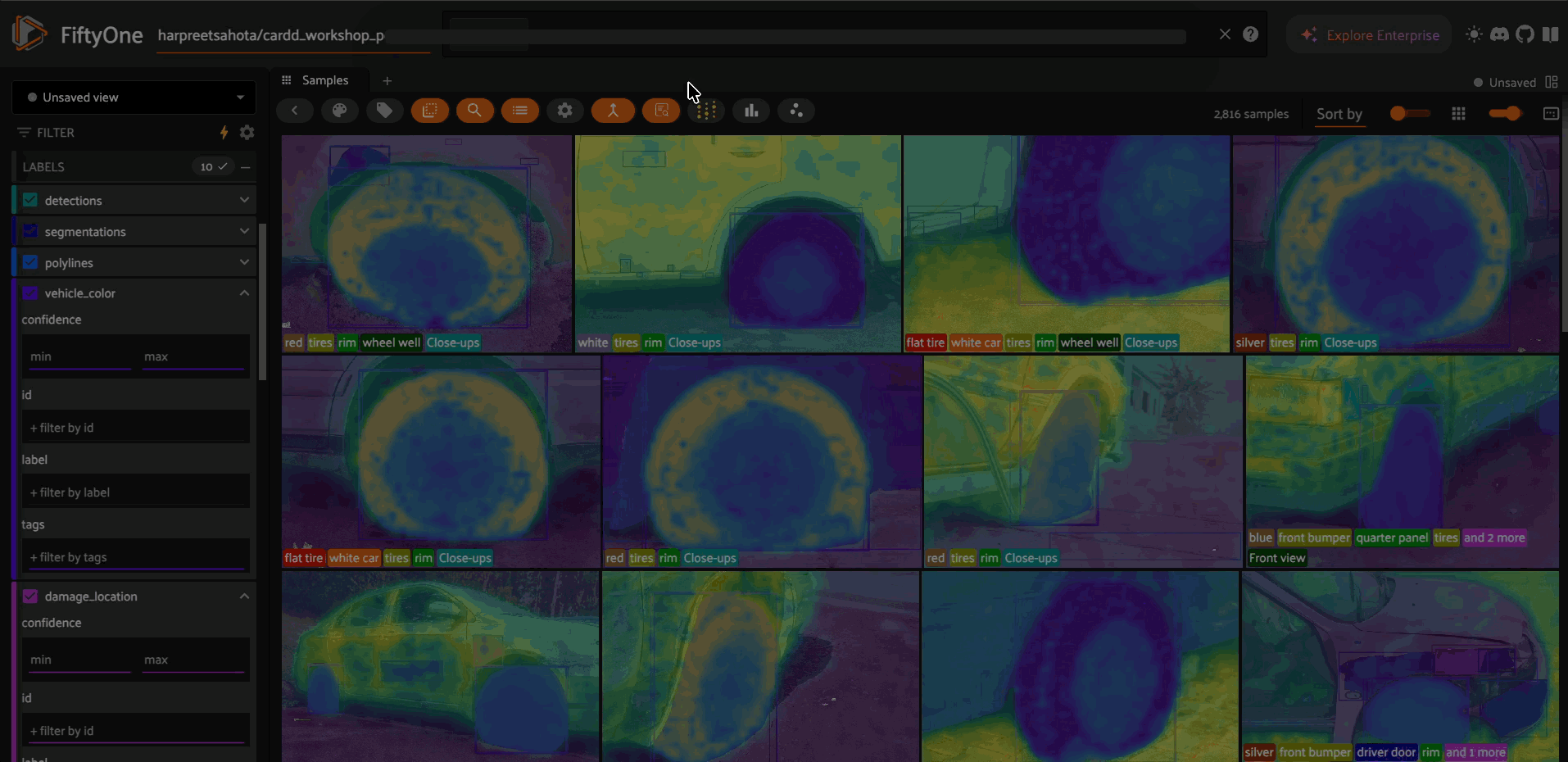
Installation#
# Install dependencies
pip install -U fiftyone wandb
# Download and install plugin
fiftyone plugins download https://github.com/harpreetsahota204/fiftyone_wandb_plugin
# Verify installation
fiftyone plugins list
# Should show: @harpreetsahota/wandb
Configuration#
Set your WandB credentials as environment variables:
# Required
export FIFTYONE_WANDB_API_KEY="your-api-key-here"
# Optional (can also specify per-operation)
export FIFTYONE_WANDB_ENTITY="your-username-or-team"
export FIFTYONE_WANDB_PROJECT="your-default-project"
Get your API key at wandb.ai/authorize.
Alternative: Use wandb login to cache credentials locally.
Quick Start#
1. Track Training Data#

import fiftyone as fo
import fiftyone.operators as foo
import wandb
# Load and curate your data
dataset = fo.load_dataset("my_dataset")
train_view = dataset.match_tags("train")
# Start WandB run
wandb.init(project="my-project", name="experiment-1")
# Log the training view with all labels
operator = foo.get_operator("@harpreetsahota/wandb/log_fiftyone_view_to_wandb")
operator(
train_view,
project="my-project",
run_id=wandb.run.id,
include_labels=True # Logs all label types to WandB Table
)
# Train your model...
wandb.finish()
What gets logged to WandB:
Sample IDs (for exact reproducibility)
All label fields (Detection, Classification, Segmentation, etc.)
Dataset statistics and metadata
Thumbnail images in interactive WandB Tables
2. Track Model Predictions#
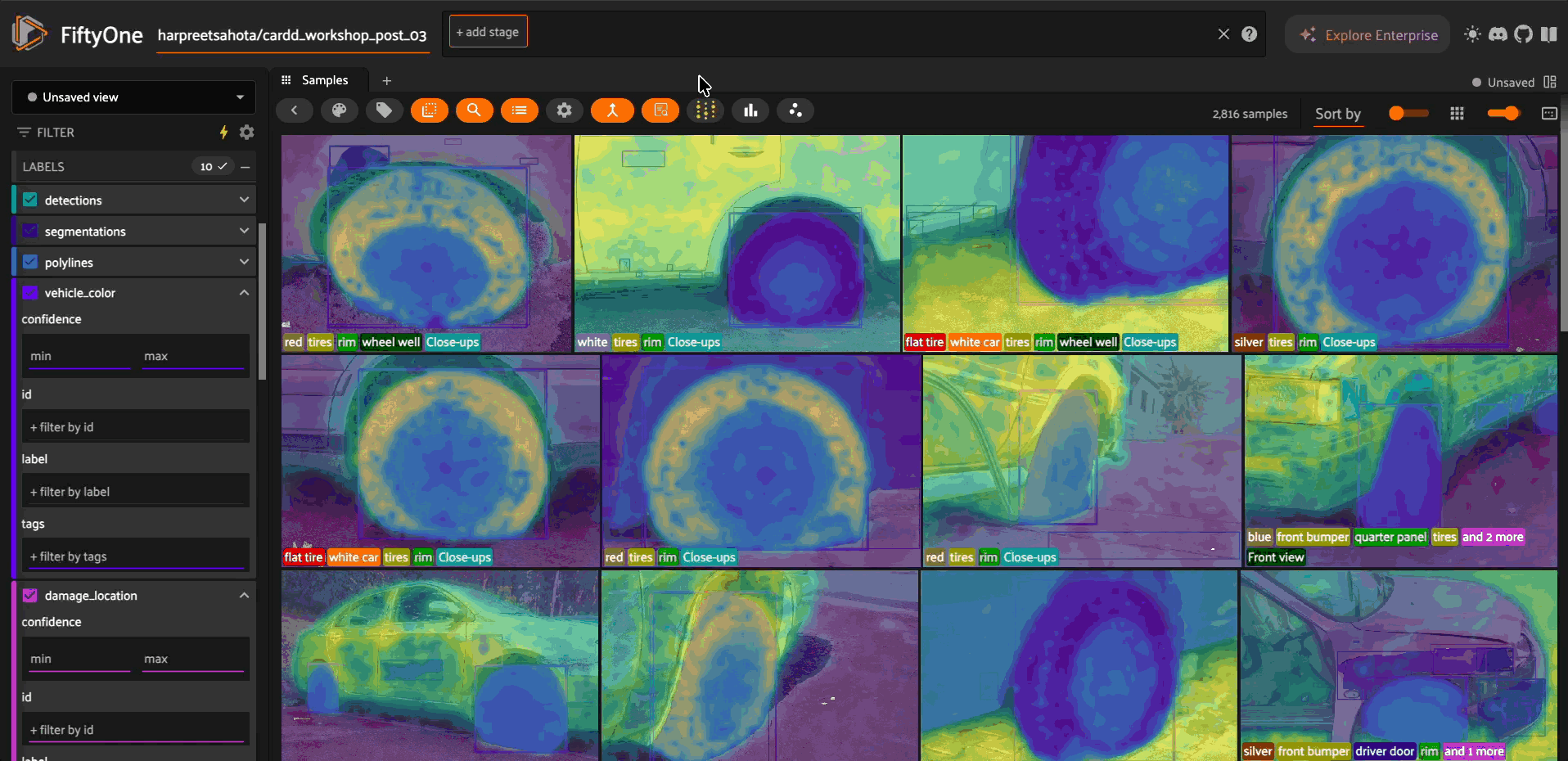
import fiftyone.zoo as foz
# Load model and run inference
model = foz.load_zoo_model("yolov8n-coco-torch")
dataset.apply_model(model, label_field="predictions")
# Log predictions to WandB
operator = foo.get_operator("@harpreetsahota/wandb/log_model_predictions")
result = operator(
dataset,
model_name="yolov8n",
model_version="v1.0",
predictions_field="predictions",
project="my-project"
)
print(f"Logged {result['total_predictions']} predictions")
print(f"View in WandB: {result['wandb_url']}")
What gets logged:
Per-sample prediction counts:
"person(5), car(3), dog(2)"Average confidence scores
Class distribution across all predictions
Low-confidence label IDs for active learning
Complete Examples#
Example 1: Data Ablation Study#
Compare model performance on different data curation strategies:
import fiftyone as fo
import fiftyone.operators as foo
from fiftyone import ViewField as F
import wandb
dataset = fo.load_dataset("my_dataset")
operator = foo.get_operator("@harpreetsahota/wandb/log_fiftyone_view_to_wandb")
# Experiment 1: Full dataset baseline
wandb.init(project="ablation", name="baseline-full")
operator(dataset, project="ablation", run_id=wandb.run.id, include_labels=True)
wandb.finish()
# Experiment 2: High quality samples only
wandb.init(project="ablation", name="high-quality-only")
high_quality = dataset.match(F("quality_score") > 0.8)
operator(high_quality, project="ablation", run_id=wandb.run.id, include_labels=True)
wandb.finish()
# Experiment 3: Balanced class distribution
wandb.init(project="ablation", name="balanced-classes")
balanced = dataset.take(100, seed=42) # Smart sampling per class
operator(balanced, project="ablation", run_id=wandb.run.id, include_labels=True)
wandb.finish()
# Compare in WandB to see which curation strategy yields best results!
Example 2: Model Version Comparison#
Track predictions from different model versions:
import fiftyone as fo
import fiftyone.operators as foo
import fiftyone.zoo as foz
dataset = fo.load_dataset("my_dataset")
operator = foo.get_operator("@harpreetsahota/wandb/log_model_predictions")
# Model V1: YOLOv8 Nano
model_v1 = foz.load_zoo_model("yolov8n-coco-torch")
dataset.apply_model(model_v1, label_field="predictions_v1")
operator(
dataset,
model_name="yolov8n",
model_version="v1.0",
predictions_field="predictions_v1",
project="model-comparison"
)
# Model V2: YOLOv8 Small (larger, more accurate)
model_v2 = foz.load_zoo_model("yolov8s-coco-torch")
dataset.apply_model(model_v2, label_field="predictions_v2")
operator(
dataset,
model_name="yolov8s",
model_version="v2.0",
predictions_field="predictions_v2",
project="model-comparison"
)
# Check WandB artifacts to compare:
# - Prediction counts per sample
# - Class distributions
# - Confidence levels
Example 3: Active Learning Workflow#
Use WandB artifacts to drive your active learning loop:
import fiftyone as fo
import fiftyone.operators as foo
import fiftyone.zoo as foz
import wandb
dataset = fo.load_dataset("my_dataset")
# Step 1: Apply model and log predictions
model = foz.load_zoo_model("yolov8n-coco-torch")
dataset.apply_model(model, label_field="predictions")
operator = foo.get_operator("@harpreetsahota/wandb/log_model_predictions")
result = operator(
dataset,
model_name="yolov8n",
predictions_field="predictions",
project="active-learning"
)
# Step 2: Download artifact to get low-confidence detections
api = wandb.Api()
artifact = api.artifact(f"entity/active-learning/{result['artifact_name']}:latest")
low_conf_label_ids = artifact.metadata["low_confidence_label_ids"]
print(f"Found {len(low_conf_label_ids)} uncertain predictions")
# Step 3: Select those specific detections in FiftyOne
uncertain_view = dataset.select_labels(ids=low_conf_label_ids)
session = fo.launch_app(uncertain_view)
# Step 4: Review in FiftyOne, fix labels, retrain, repeat!
Example 4: Vision-Language Model Tracking#
Track VLM inference with per-sample prompts:
import fiftyone as fo
import fiftyone.operators as foo
dataset = fo.load_dataset("traffic-dataset")
# Step 1: Add per-sample prompts to your dataset
for sample in dataset:
# Example: different prompt for each sample based on context
sample["user_prompt"] = f"Analyze frame {sample.id}: Describe all vehicles and traffic conditions."
sample.save()
# Step 2: Run your VLM inference (example)
# After inference, VLM outputs are stored as strings in a field
# For example: sample["vlm_output"] = "2 cars traveling at 65mph, 1 truck..."
# Step 3: Log to WandB with both global config and per-sample prompts
operator = foo.get_operator("@harpreetsahota/wandb/log_model_predictions")
operator(
dataset,
model_name="gpt-4-vision", # or "claude-3", "llava", etc.
predictions_field="vlm_output",
project="traffic-analysis",
# Global config (same for all samples)
model_config={
"system_prompt": "You are an expert traffic safety analyst with 20 years of experience.",
"temperature": 0.7,
"max_tokens": 150,
"model_version": "gpt-4-vision-preview"
},
# Per-sample prompts (field containing unique prompts for each sample)
prompt_field="user_prompt"
)
# WandB Table will show:
# | sample_id | prompt | predictions |
# |-----------|-------------------------------|------------------------------------------------|
# | 001 | "Analyze frame 001: Describe..." | "2 cars traveling at 65mph, 1 truck in right lane..." |
# | 002 | "Analyze frame 002: Describe..." | "Red traffic light at intersection, 2 pedestrians..." |
Using the FiftyOne App#
All operators have interactive UIs in the FiftyOne App:
Log Training View#
Open your dataset:
fo.launch_app(dataset)Create your view (apply filters, select samples)
Click backtick (`) to open the operators menu → “W&B: Save View as Artifact”
Choose target:
Dataset - All samples
Current view - Filtered samples
Selected samples - Hand-picked samples
Toggle “Include Labels” ON
Enter your WandB Run ID (optional - auto-generated if not provided)
Execute!
Log Model Predictions#
First, run inference in your script:
model = foz.load_zoo_model("yolov8n-coco-torch") dataset.apply_model(model, label_field="predictions")
Open FiftyOne App:
fo.launch_app(dataset)Optionally select specific samples
Click operators menu → “W&B: Log Model Predictions”
Fill in model name and predictions field
Execute!
Reproducing Experiments#
Recreate Training Data#
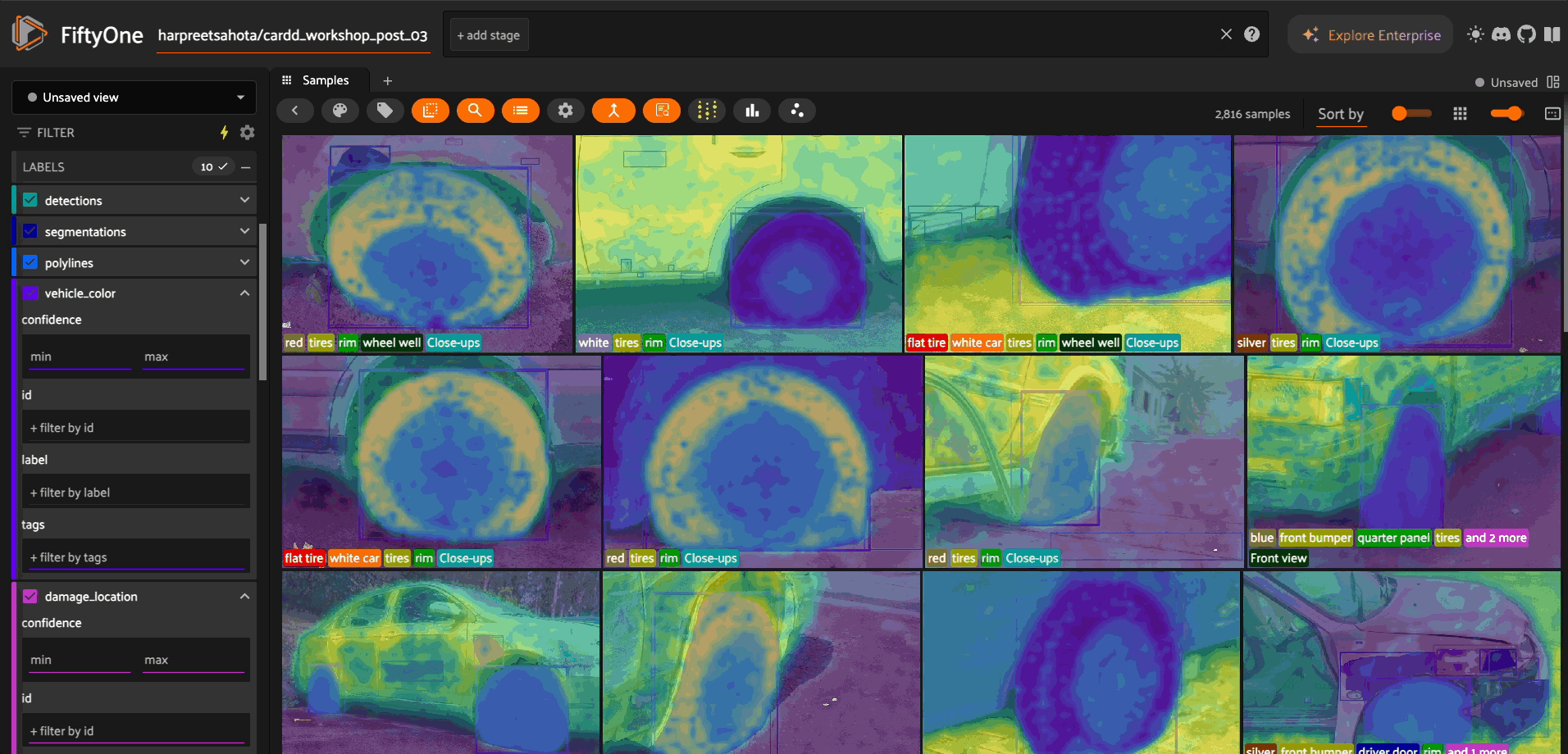
Every training view is stored with sample IDs in WandB metadata. You can recreate views either manually or using the plugin operator:
Option 1: Using the Plugin Operator (Recommended)
import fiftyone as fo
import fiftyone.operators as foo
# Open your dataset
dataset = fo.load_dataset("my_dataset")
session = fo.launch_app(dataset)
# Use the operator to load the view from WandB
# This can be done via the UI (backtick menu → "W&B: Load View from Artifact")
# Or programmatically:
operator = foo.get_operator("@harpreetsahota/wandb/load_view_from_wandb")
# Note: load_view_from_wandb currently works best through the UI
# as it needs interactive project/artifact selection
Option 2: Manual Reconstruction
import fiftyone as fo
import wandb
# Download the artifact
api = wandb.Api()
artifact = api.artifact("entity/project/training_view:v2")
# Get exact sample IDs used for training
sample_ids = artifact.metadata["sample_ids"]
# Recreate the view instantly
dataset = fo.load_dataset("my_dataset")
train_view = dataset.select(sample_ids)
print(f"Recreated training view with {len(train_view)} samples")
# Now you can:
# - Retrain on the exact same data
# - Analyze what made this experiment work
# - Compare against other versions
Link Predictions Back to Runs#
import fiftyone.operators as foo
# After training in WandB
operator = foo.get_operator("@harpreetsahota/wandb/log_wandb_run")
operator(
dataset,
project_name="my-project",
run_name="experiment-42",
predictions_field="predictions" # Links this field to the run
)
# Now in FiftyOne App:
# - Click the WandB button
# - Automatically opens the dashboard for this run
Supported Label Types#
The plugin automatically handles all 15 FiftyOne label types:
Type |
Format in WandB Table |
|---|---|
Classification |
|
Detection |
|
Detections |
|
Polyline |
|
Polylines |
|
Keypoint |
|
Keypoints |
|
Segmentation |
|
Heatmap |
|
TemporalDetection |
|
TemporalDetections |
|
GeoLocation |
|
GeoLocations |
|
Regression |
|
All labels are automatically detected and formatted for clear visualization in WandB Tables.
After running, check your WandB dashboard:
https://wandb.ai/YOUR-ENTITY/test-project
You should see:
Multiple dataset artifacts with metadata
Interactive WandB Tables showing labels
Sample IDs in artifact metadata (for reproducibility)
Troubleshooting#
“FIFTYONE_WANDB_API_KEY not set”#
export FIFTYONE_WANDB_API_KEY="your-key"
# Or: wandb login
“wandb is not installed”#
pip install wandb
“Could not find WandB run”#
Verify project name is correct
Ensure run ID exists in WandB
Check you have access to the project
Run must be finished before calling
log_fiftyone_view_to_wandb
Large datasets are slow#
For large datasets with include_labels=True, the operator automatically delegates to a background process. You’ll see a progress bar in the FiftyOne App.
To keep artifacts small:
Set
include_labels=False(lightweight mode)Use
include_images=Falsewhen logging predictionsFilter your view before logging
Plugin Operators#
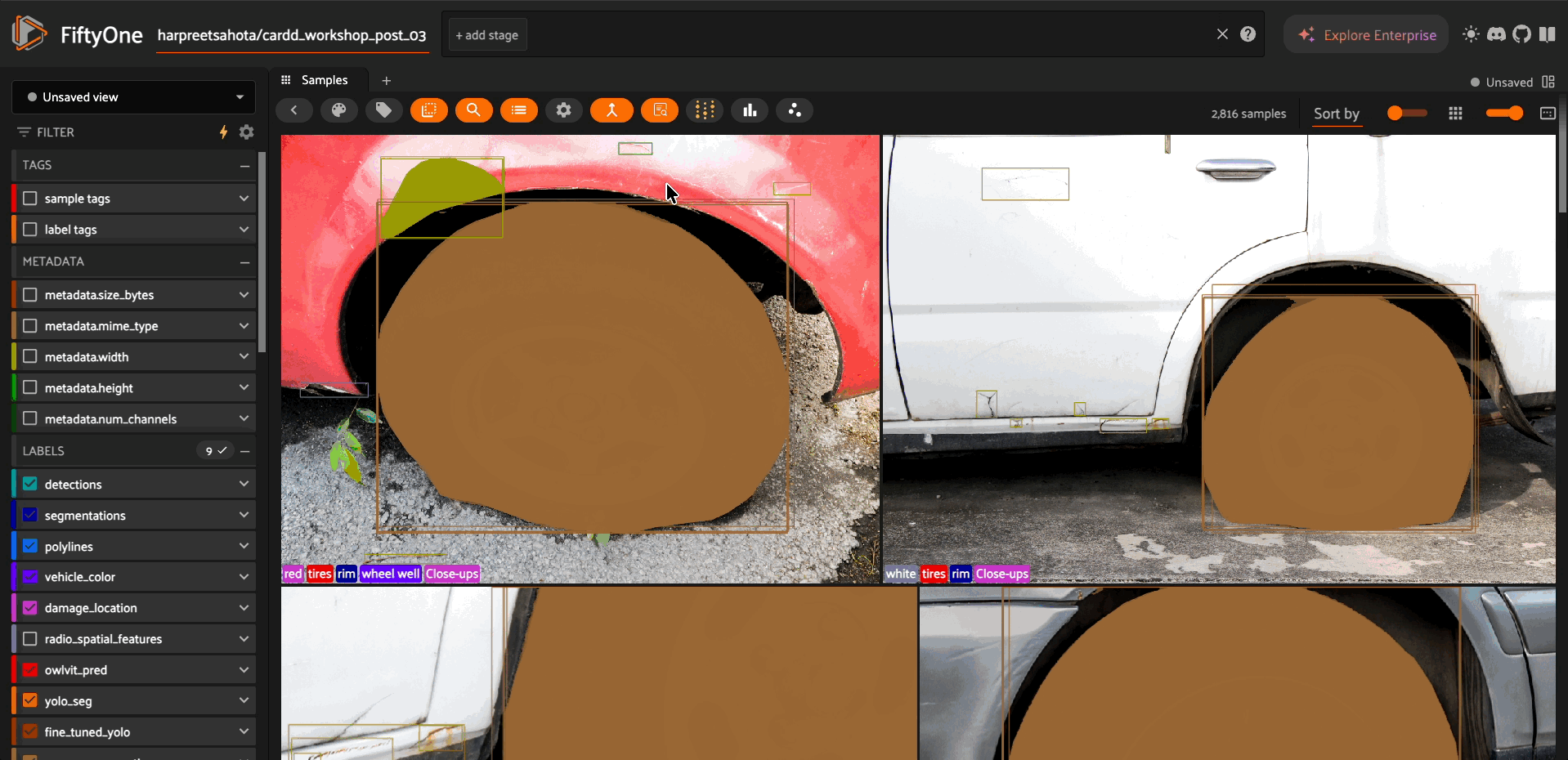
The plugin provides these operators (accessible via Python or FiftyOne App):
Operator |
Purpose |
|---|---|
|
Log training data to WandB |
|
Log inference results to WandB |
|
Recreate FiftyOne view from WandB artifact |
|
Link WandB run to FiftyOne dataset |
|
Display WandB run in FiftyOne panel |
|
Display WandB report in FiftyOne panel |
|
Open WandB panel in FiftyOne App |
|
Retrieve run metadata |
Best Practices#
1. Always Log Training Views#
# Good: Track what data was used
wandb.init(project="my-project")
operator(train_view, project="my-project", run_id=wandb.run.id, include_labels=True)
# Train...
# Bad: No record of training data
wandb.init(project="my-project")
# Train... (what data was used? )
2. Use Descriptive Artifact Names#
# Good
operator(view, artifact_name="coco_train_high_quality_v2", ...)
# Bad (auto-generated)
operator(view, ...) # Creates "training_view_abc123"
3. Version Your Data#
# Track data improvements over time
operator(view_v1, artifact_name="training_data_v1", ...)
# ... improve data curation ...
operator(view_v2, artifact_name="training_data_v2", ...)
# ... compare results in WandB ...
4. Log Early in Training Scripts#
# Good: Log right after wandb.init()
wandb.init(project="my-project")
operator(view, project="my-project", run_id=wandb.run.id, include_labels=True)
# Train...
wandb.finish()
# Bad: Logging at the end
# Train...
operator(...) # Too late! Run may have failed
wandb.finish()
Links#
License#
This plugin is licensed under the Apache 2.0 license
